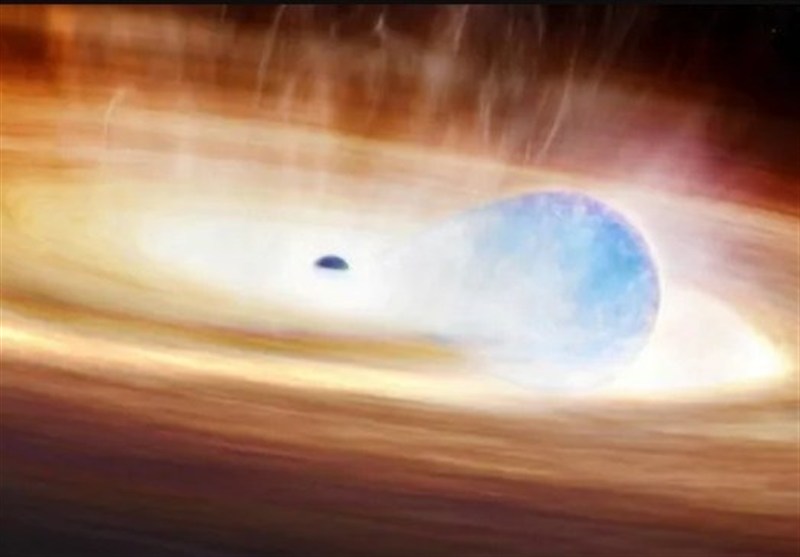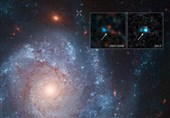Peculiar Supernova Prompts New Theories about Cosmos
TEHRAN (Tasnim) – A new discovery about what happens when a supernova – an exploding star – and a black hole collide could change the way scientists understand the lives and deaths of stars.
The finding was the first time astrophysicists have observed a giant star exploding as the result, they believe, of its interaction with a dense black hole. The supernova was triggered by the intense gravitational stress of trying to "swallow" the black hole up, the study's authors say.
The phenomenon may happen more than scientists realize, and new tools to observe supernova explosions could reveal other instances of black holes sparking supernovas, according to the lead study author.
"If that is much more common, then it would transform the way we think about how stars explode," said Alex Gagliano, lead author of the study and fellow at the National Science Foundation Institute for Artificial Intelligence and Fundamental Interactions.
One of the coolest parts of the discovery is that it was made possible by the use of artificial intelligence, or AI, Gagliano said. AI helped flag a star behaving unusually early on, which allowed the team to closely monitor as a surprising event unfolded.
The study, published in the Astrophysical Journal, was conducted by a team led by the Center for Astrophysics, a collaboration between Harvard and the Smithsonian, and the Massachusetts Institute of Technology. It was part of the Young Supernova Experiment, which hopes to discover thousands of new cosmic explosions.
A supernova is the spectacular explosion of a gigantic dying star. Stars – giant balls of gas – all have a life cycle, which can range from millions to trillions of years, according to NASA. When a huge star, several times the mass of the Sun, runs out of its nuclear fuel at its center, gravity's force takes over and it suddenly collapses, creating shock waves that cause the outer part of the star to explode into a supernova.
A supernova typically leaves behind a very dense core. The very largest supernovas leave behind black holes, infamous for their great mystery. Black holes are points in the universe where gravity is so strong that nothing, not even light, can get out, NASA says. Their gravity is so strong because matter is squeezed into a tiny space. Because no light can escape, black holes are invisible, but scientists can spot evidence of them when they suck in matter and gas, which glow as they near the black hole.
Sometimes black holes are observed to have companion stars, stars that orbit around them. That's the interaction researchers zeroed in on in this new discovery.
The discovery of the supernova dubbed SN 2023zkd was so unusual because it put together pieces of a puzzle that had never been seen together before, Gagliano said. Usually, a supernova explosion gets brighter over a period of a week or two before reaching its peak and then gets dimmer, he said.
At first, SN 2023zkd looked like a typical supernova explosion, just a sudden peak of brightness. But it dimmed at an unusually slow rate afterward, causing an AI program to flag it for further study. Scientists watched its decline for months, and then came a very strange behavior: It began to brighten again in a second peak.
To understand this, the researchers looked back at old archival data and discovered that before its first blast, the star had been slowly brightening for a period of about four years, an incredibly uncommon sight. All these factors combined pointed to one likely explanation.
About 730 million light-years from Earth, SN 2023zkd had been a star locked in an orbital dance with a black hole, and as they gradually got closer to one another, the black hole pulled at the star's material, causing the gradually increasing glow, Gagliano said. At the moment of the explosion, the star and black hole became so close that the star couldn't survive anymore, he said.
The extreme gravitational stress from the black hole caused the supernova explosion. The second peak of brightness happened when the explosion itself collided with a disc-like cloud of dust and gas leftover from the interaction between the star and the black hole.
"It's been known for a long time that the majority of stars have companions that interact with them at some point during their lives... but we never really thought that this interaction played a leading role in driving the death of a star," Gagliano said. "That is something that is very new and exciting and I think will force us to revisit how we think about simulating the end of a star."
The explosion was first discovered in July 2023, after the research team was alerted to unusually slow dimming of the glow of a supernova. The alert came from an AI program designed to scan the sky for all the supernovas and each morning report on any unusual activity.
The alert allowed the researchers to continue to observe the supernova and see as it shockingly began to brighten again, indicating a second explosion.
Were it not for the AI program, the initial explosion may have just looked observationally like many other supernovas and scientists would never have looked back to see its slow brightening and deduced that it was interacting with a black hole, Gagliano said. AI's role in sifting through mountains of data that human researchers can't and flagging anomalies is growing in several scientific fields, from medicine to astrophysics, Gagliano said.
"One of the only reasons that we were able to make this discovery and understand how scientifically interesting it was was through the combination of researchers in machine learning and in astrophysics," he said.






